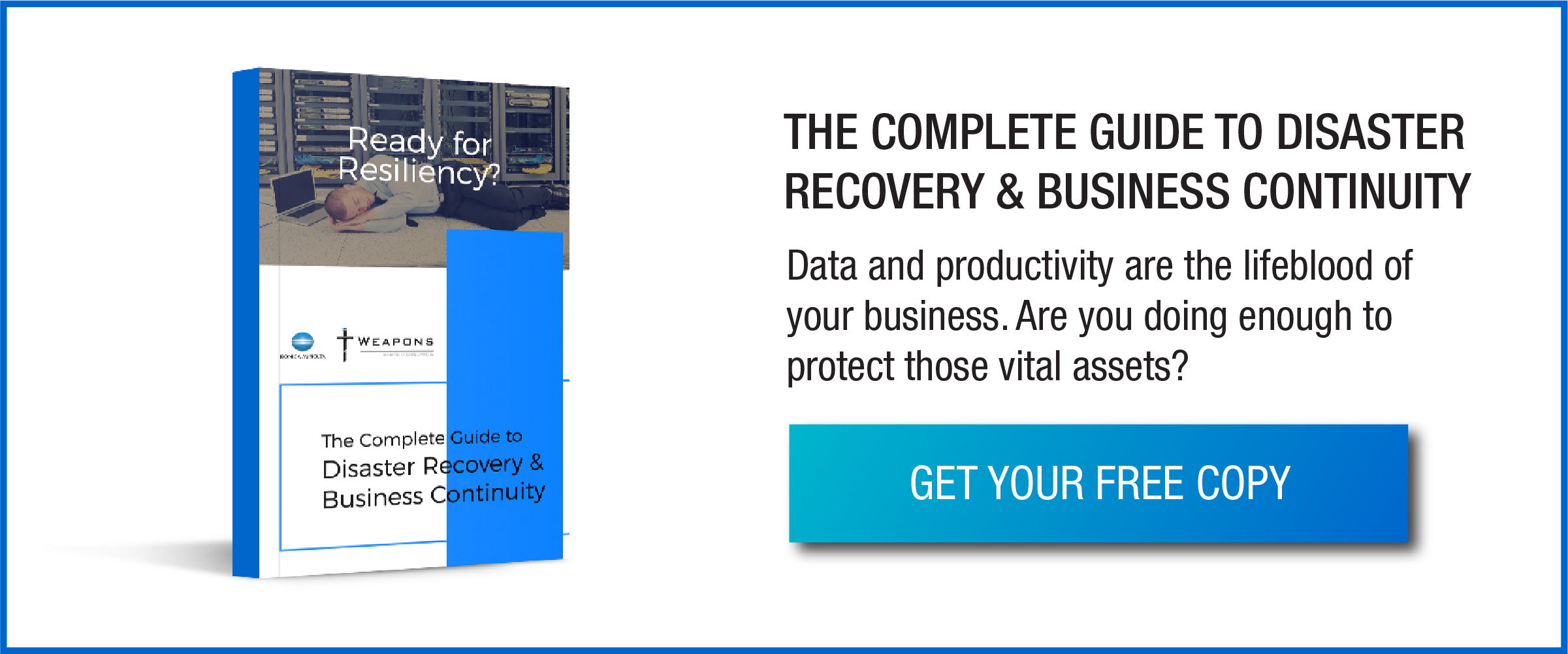After a year of one disaster after another, scenarios once considered “what if” have reached “not if, but when” status. Even if the disaster is more commonplace, like a hardware failure, it could still result in massive data loss. It is in recognition of these disasters that World Backup Day was founded. On this day, many individuals and businesses alike take the pledge “I solemnly swear to backup my important documents and precious memories on March 31st.”
Pandemic aside, we’ve seen some stellar examples of different types of disasters this year, including the ransomware attack that shut down online systems for the city of St John, the double hurricanes that formed in the Gulf of Mexico, and a human error that exposed the driver’s license information of almost 30 million people in Texas.
Although the kinds of disasters are various, their impact is fairly predictable. There are four common business considerations when it comes to dealing with any type of disaster: business continuity, preventing data loss, maintaining customer and stakeholder trust, and upholding compliance and regulatory requirements.
Downtime is a revenue and productivity killer, so it’s crucial to get business operations up and running quickly after an unplanned disruption. Creating a comprehensive business continuity plan before you actually need it is key to resuming normal-ish business functions during and after a disaster.
Data loss prevention is a vital component in disaster risk mitigation. It doesn’t take a tsunami to wipe out business-critical data. Something as low-key as a power outage or software update gone awry will do the trick just as well. In fact, human error accounts for the vast majority of data loss incidents.
Disruptions and security breaches will cost your organization more than just money. Today’s consumers are fiercely focused on protecting data privacy. Any hint that your organization isn’t taking security seriously can cause your customers to ditch you for your competitor. Data exposure and loss also have legal and regulatory ramifications, which can get expensive fast between legal fees, fines, and settlements.
In 2020, many businesses learned a valuable lesson: Expect the unexpected. The best way to accomplish this is to adopt a proactive approach to risk mitigation by implementing secure backups and a rock-solid disaster recovery strategy.
Although backup and disaster recovery sound like they serve the same purpose and you could get away with having one or the other, the reality is backup and disaster recovery work hand in hand to provide optimal protection against data loss and prolonged system downtime.
To get the maximum benefit from your data protection strategy, it’s important to fully understand the roles backup and disaster recovery play and why being proactive is a smart business decision.
Backups
Backups are copies of your organization’s data that can be used to recover and restore data after a disaster, deletion, or unplanned outage. Backups should be part of a comprehensive disaster recovery strategy, but they cannot fully enable business continuity.
There are situations when you may need to restore from a backup without needing to initiate a full disaster recovery response; for example a corrupt database, an update that goes bad, or someone accidentally deleting files.
Backups are intended to protect business-critical data and systems, so it’s important to do a thorough inventory of your company’s assets and resources that need to be included in the backup. For most organizations this list will include:
- Mobile devices and laptops
- Applications
- Files/data
- Operating systems
- Virtual servers and cloud infrastructure
- Software and hardware configurations across your entire IT ecosystem
Remember, your data recovery and restoration will only be as good as your last complete backup. So, be sure to back up frequently and test your backup and restore processes so you know they will work when you need them to.
Disaster Recovery
Disaster recovery is a strategy that includes all of the processes and plans needed for your organization to respond to and recover from a disaster. Unlike backups alone, the disaster recovery plan enables business continuity and the restoration of key services and access to data in case of an incident.
Individual organizations need to tailor their recovery strategy to meet specific business objectives, but at a high level, every disaster plan should include some basic components. These include:
Business impact analysis
Which mission-critical systems and processes need to be included in the disaster recovery plan.
Risk analysis
A list of potential threats to business continuity, including natural disasters, human error, and cyberthreats, and an estimate of the likelihood of each scenario happening.
Disaster recovery team
The people in charge of implementing the disaster response. The team should include representatives from all levels and business units in the organization.
Inventory of assets
A list of everything: hardware, software, mobile devices, and other equipment. Ask for input from every department to make sure the inventory is complete.
Defined recovery time objectives (RTO) and recovery point objectives (RPO)
Metrics that define how long an application can be down before the business is significantly harmed (RTO) and the maximum amount of data that can be lost before the business is negatively impacted (RPO).
Alternative workspace and remote network access
A well-appointed workspace for employees if the office is inaccessible and secure access to necessary files and applications from any location help minimize downtime. Redundant internet connectivity, VPNs for secure access and other tools can provide your team secure access to core apps and data in times of disruption.
Secure backups
A backup copy stored in the cloud for easy remote access. Some ransomware strains specifically target backup files, so be sure to keep a copy of the backup separate from the company network.
Why It’s Important to Be Proactive About Data Protection
The middle of a crisis is the wrong time to make tough decisions about how to protect your company’s systems and data. An effective disaster recovery strategy requires a comprehensive business continuity plan, an understanding of the financial impact of downtime, and an awareness of the legal and regulatory repercussions of data loss.
How IT Weapons Can Help Keep Your Business Safe With Data Backups and Disaster Recovery
IT Weapons backup and data protection solutions provide peace of mind that your data is secure whether it’s housed in the cloud or in your office. With flexible, scalable, and resilient backup and disaster recovery options for public, private, and hybrid cloud environments and a turnkey, all-in-one solution to protect on-prem data, IT Weapons offers simple answers to complex data protection problems.
Our team of experts is dedicated to creating a solid disaster recovery and business continuity strategy individualized to meet your organization’s needs, including 24/7 monitoring and support, fully encrypted disk-based backup and archiving solutions, server replication and restoration, multisite failover, and high-availability storage.
As businesses navigate their next steps in these unusual times, data protection is critical. Download “The Complete Guide to Disaster Recovery & Business Continuity” to learn more about securing your data and applications against natural disasters, new and evolving cyberthreats, and simple human error.
Isn’t it time you felt safe?





